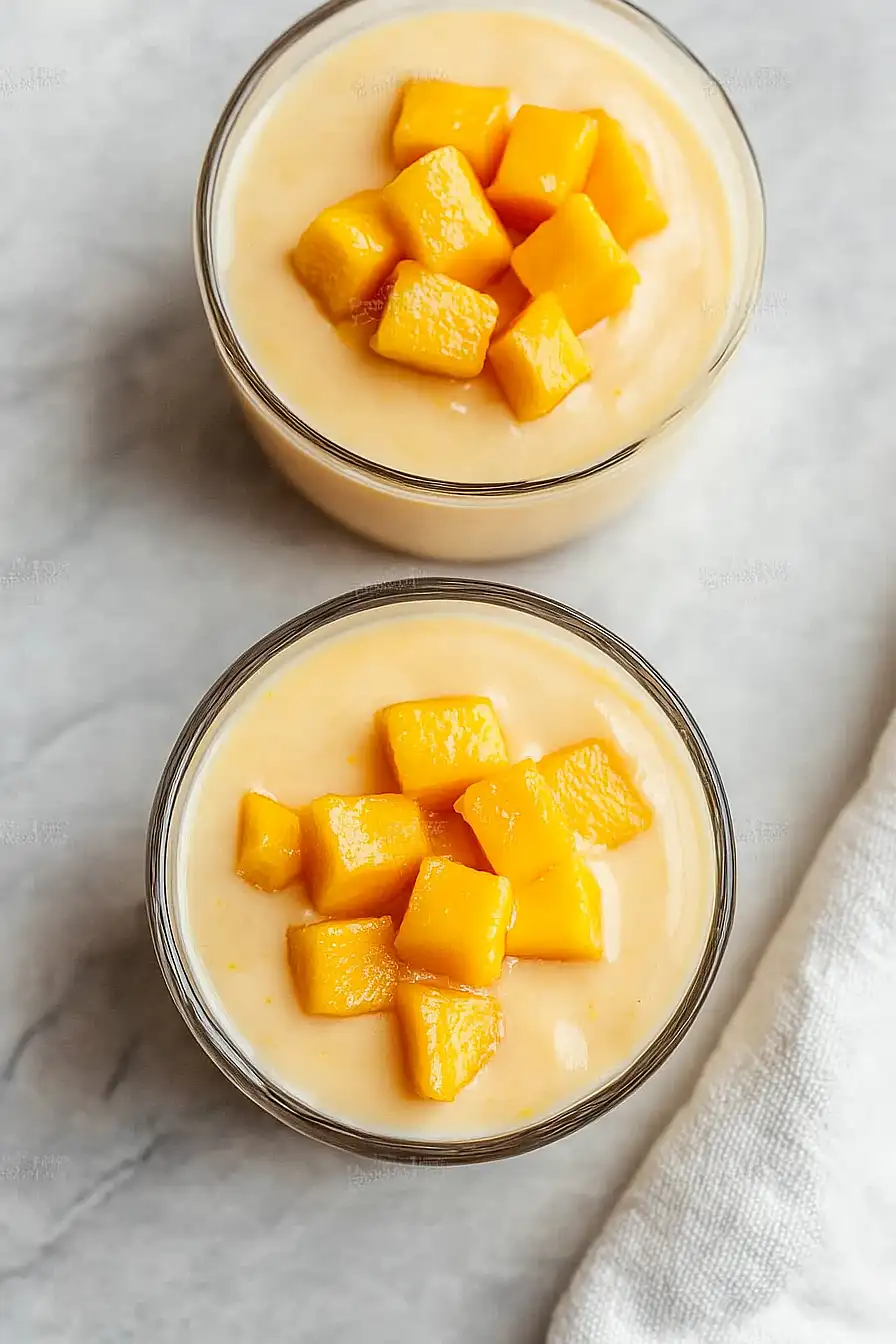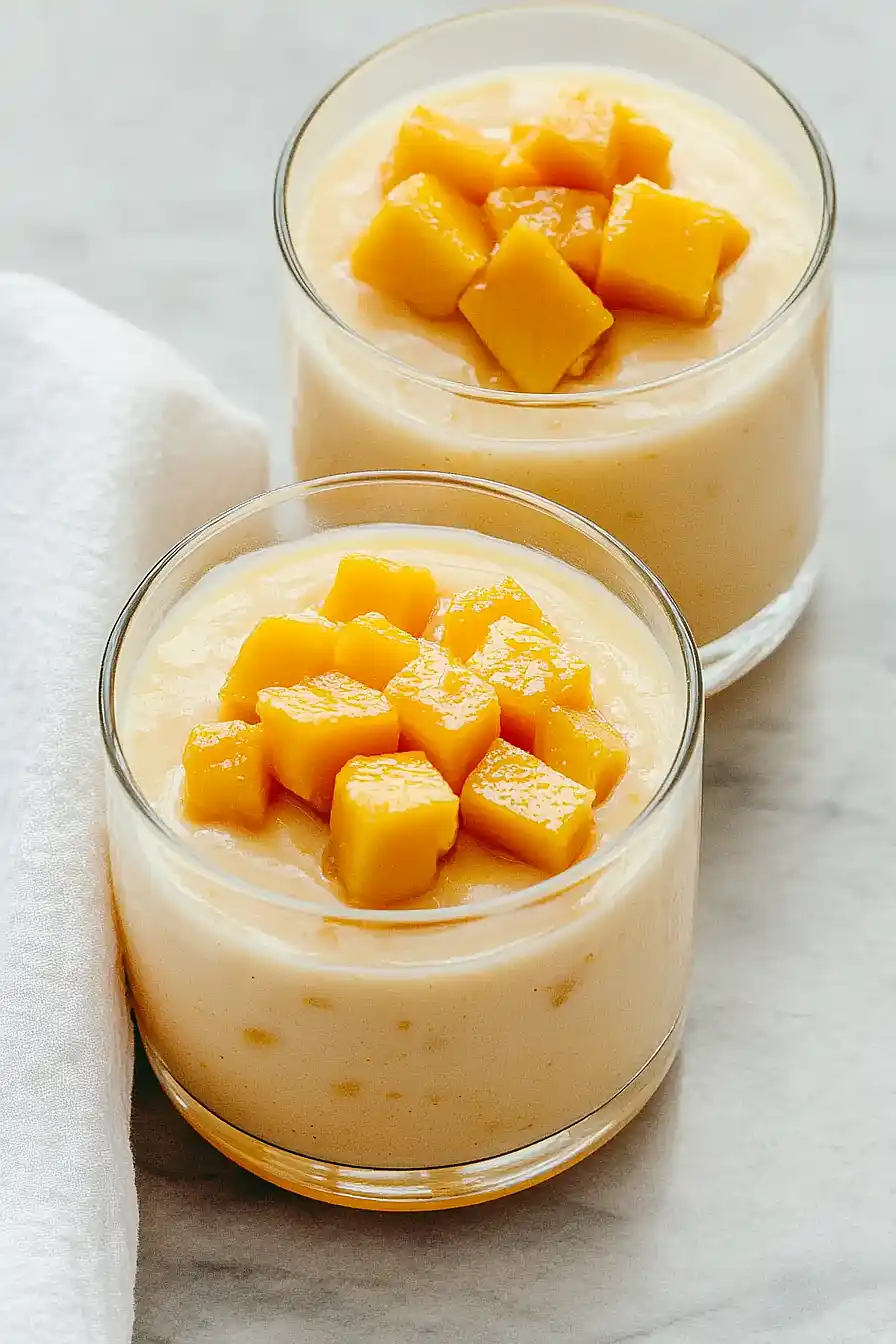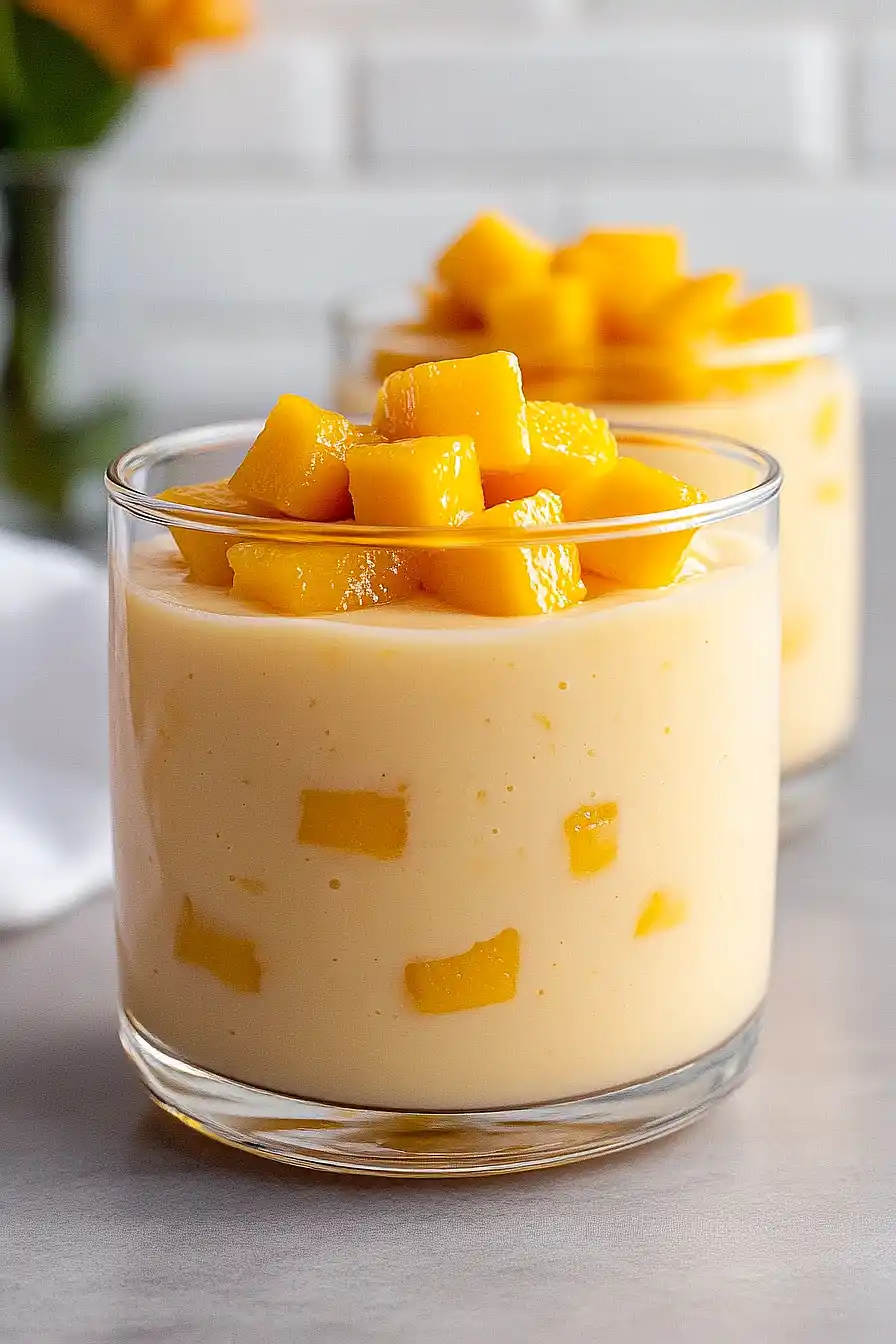Disclaimer: Our editors have used AI to create or enhance parts of this article. All content has been fact-checked by our team to ensure accuracy.
Finding a simple, crowd-pleasing dessert that doesn’t require hours in the kitchen can feel impossible sometimes. Between work deadlines, soccer practice pickups, and everything else life throws at you, the last thing you want is a complicated recipe that leaves you stressed and your kitchen looking like a disaster zone.
That’s where this mango pudding comes to the rescue: it’s creamy and satisfying, takes just minutes to whip together, and uses ingredients you can easily find at any grocery store.

Why You’ll Love This Mango Pudding
- Fresh mango flavor – Made with real mango chunks instead of artificial flavoring, this pudding tastes like summer in every spoonful.
- Simple ingredients – You only need six basic ingredients that you can easily find at any grocery store, making this an accessible dessert for anyone to try.
- Make-ahead friendly – This pudding needs time to set in the fridge, which means you can prepare it hours or even a day before serving, perfect for dinner parties or meal prep.
- Light and creamy texture – The combination of fresh mango and heavy cream creates a smooth, silky pudding that’s rich but not too heavy, making it a perfect ending to any meal.
- Naturally gluten-free – This dessert works great for guests with gluten sensitivities, and it’s fancy enough to impress without being complicated to make.
What Kind of Mango Should I Use?
For the best mango pudding, you’ll want to use ripe, sweet mangoes that give slightly when pressed but aren’t mushy. Popular varieties like Ataulfo (honey mangoes), Kent, or Tommy Atkins all work well for this recipe. If your mangoes are a bit underripe, don’t worry – you can adjust the sugar to taste. Frozen mango chunks are also a great option if fresh mangoes aren’t available or in season, just make sure to thaw them completely and drain any excess liquid before blending. The key is choosing mangoes that are fragrant and have good color, as this will give your pudding the best flavor and natural sweetness.

Options for Substitutions
This creamy mango pudding is pretty forgiving when it comes to swaps:
- Fresh mango: If fresh mangoes aren’t available, you can use frozen mango chunks (thaw them first) or even canned mango pulp. Just reduce the water slightly if using canned pulp since it’s already quite smooth.
- Gelatin: For a vegetarian option, swap gelatin with agar powder – use about 1 teaspoon of agar powder instead of the 2 tablespoons of gelatin. Agar sets at room temperature and creates a slightly firmer texture.
- Heavy cream: You can substitute with coconut cream for a dairy-free version, or use half-and-half for a lighter pudding. Coconut cream will add a subtle tropical flavor that pairs nicely with mango.
- Sugar: Feel free to adjust the sweetness based on your mango’s ripeness. You can also use honey, maple syrup, or agave – just reduce the amount slightly since these are sweeter than regular sugar.
- Water: The water amounts are pretty important for proper gelatin activation, so try to stick close to the measurements. However, you could replace some of the water with coconut water for extra tropical flavor.
Watch Out for These Mistakes While Cooking
The biggest mistake when making mango pudding is not properly dissolving the gelatin, which can leave you with lumpy, grainy texture instead of smooth creaminess – always sprinkle gelatin over cold water first and let it bloom for 5 minutes before heating gently until completely dissolved.
Another common error is adding the gelatin mixture to hot mango puree, which can cause the gelatin to seize up and create strings, so make sure your mango mixture has cooled to room temperature before combining.
Don’t skip straining your mango puree through a fine mesh sieve, as this removes any fibrous bits that could ruin the silky texture, and when folding in the whipped cream, do it gently to maintain the light, airy consistency.
Finally, resist the urge to check if it’s set too early – give your pudding at least 4 hours in the fridge to properly firm up, or it might collapse when you try to unmold it.

What to Serve With Mango Pudding?
This creamy mango pudding is perfect on its own, but I love serving it with some fresh tropical fruits like sliced kiwi, pineapple chunks, or berries for extra color and flavor. A few crispy coconut cookies or vanilla wafers on the side make great little scoops for the pudding, especially if you’re serving it to kids. For a more grown-up presentation, try topping each serving with a sprinkle of toasted coconut flakes or a drizzle of passion fruit pulp. You can also serve it alongside some light shortbread cookies or even fresh mint leaves for a refreshing finish to any meal.
Storage Instructions
Refrigerate: Mango pudding needs to stay chilled to keep its perfect texture. Cover each serving with plastic wrap or store in airtight containers in the fridge for up to 4 days. The gelatin will keep everything nice and set, so you can make this a day or two ahead for parties or meal prep.
Make Ahead: This is actually one of those desserts that tastes better after sitting overnight! The flavors meld together beautifully, and the texture becomes even more smooth and creamy. Just make sure to give it at least 4 hours to fully set before serving.
Serve: Take the pudding out of the fridge about 10 minutes before serving if you want it slightly less firm. You can garnish with fresh mango pieces, whipped cream, or even some toasted coconut flakes right before serving. Once it’s been at room temperature for more than 2 hours, pop it back in the fridge.
| Preparation Time | 15-20 minutes |
| Cooking Time | 10-15 minutes |
| Total Time | 130-135 minutes |
| Level of Difficulty | Medium |
Estimated Nutrition
Estimated nutrition for the whole recipe (without optional ingredients):
- Calories: 1200-1300
- Protein: 4-6 g
- Fat: 80-90 g
- Carbohydrates: 150-160 g
Ingredients
For the mango layer:
- 3 cups fresh mango pieces
- 1/2 cup water
For the cream gelatin mixture:
- 2 1/2 tbsp granulated sugar
- 2 tbsp powdered gelatin (about 13 g, or 2 packets)
- 150 ml water
- 250 ml heavy cream
Step 1: Blend the Mango
- 2 cups fresh mango pieces
- 1/2 cup water
Combine 2 cups of fresh mango pieces with 0.5 cups of water in a blender.
Blend until smooth to create a mango puree.
If you prefer a smoother texture, strain the puree to remove any fibers.
Step 2: Heat Cream and Dissolve Sugar
- 250 ml heavy cream
- 2 1/2 tbsp granulated sugar
In a small pot over medium heat, add the heavy cream and granulated sugar.
Stir regularly and heat until the sugar is fully dissolved.
Do not allow the cream to boil.
Step 3: Dissolve the Gelatin
- 2 tbsp powdered gelatin (about 13 g, or 2 packets)
- 150 ml water
In a separate small bowl, pour 150 ml of water and sprinkle in the powdered gelatin.
Allow it to bloom for a few minutes, then gently warm the mixture (either by microwaving in short bursts or over a hot water bath) to dissolve the gelatin completely.
I find it helpful to stir constantly to avoid lumps.
Step 4: Combine Mango Puree, Cream Mixture, and Gelatin
- mango puree from Step 1
- cream and sugar mixture from Step 2
- dissolved gelatin from Step 3
Gently mix the mango puree (from Step 1) with the warm cream and sugar mixture (from Step 2) until well combined.
Then, add the dissolved gelatin (from Step 3) and whisk or stir thoroughly to ensure everything is evenly mixed.
Step 5: Assemble and Chill the Dessert
- 1 cup fresh mango pieces
- mango cream-gelatin mixture from Step 4
Dice the remaining 1 cup of fresh mango and distribute it evenly into your serving container(s).
Pour the mango cream-gelatin mixture (from Step 4) over the mango pieces.
Place in the refrigerator and chill for at least 2 hours or overnight, until fully set.
For a more intense mango flavor, I sometimes layer more mango pieces on top before chilling.
Step 6: Serve
Once set, serve the chilled mango dessert.
Top with additional fresh mango pieces and a drizzle of condensed milk if desired for extra richness and sweetness.

